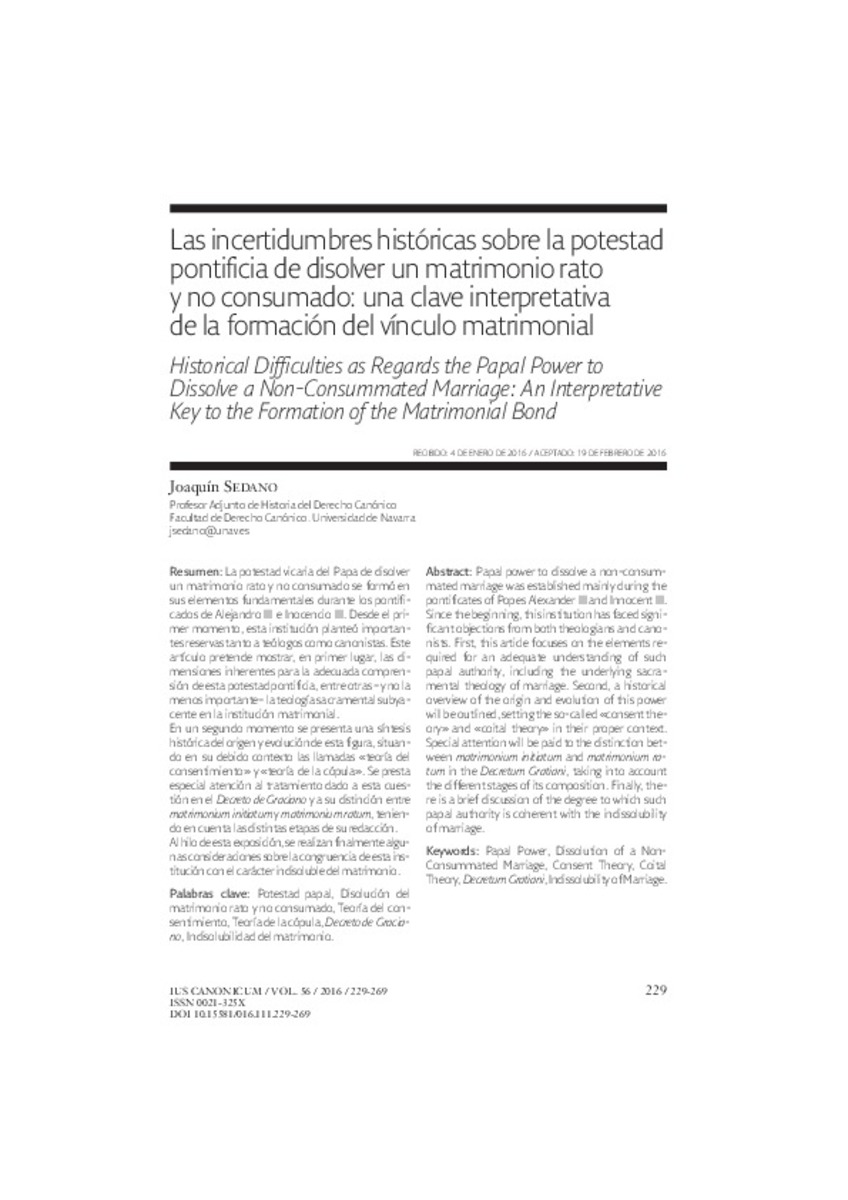Full metadata record
| DC Field | Value | Language |
|---|---|---|
| dc.creator | Sedano, J. (Joaquin) | - |
| dc.date.accessioned | 2018-06-11T10:17:42Z | - |
| dc.date.available | 2018-06-11T10:17:42Z | - |
| dc.date.issued | 2016 | - |
| dc.identifier.citation | Sedano, J. (Joaquin) | es |
| dc.identifier.issn | 0021-325X | - |
| dc.identifier.uri | https://hdl.handle.net/10171/53090 | - |
| dc.description.abstract | La potestad vicaria del Papa de disolver un matrimonio rato y no consumado se formó en sus elementos fundamentales durante los pontificados de Alejandro III e Inocencio III. Desde el primer momento, esta institución planteó importantes reservas tanto a teólogos como canonistas. Este artículo pretende mostrar, en primer lugar, las dimensiones inherentes para la adecuada comprensión de esta potestad pontificia, entre otras –y no la menos importante– la teología sacramental subyacente en la institución matrimonial. En un segundo momento se presenta una síntesis histórica del origen y evolución de esta figura, situando en su debido contexto las llamadas «teoría del consentimiento» y «teoría de la cópula». Se presta especial atención al tratamiento dado a esta cuestión en el Decreto de Graciano y a su distinción entre matrimonium initiatum y matrimonium ratum, teniendo en cuenta las distintas etapas de su redacción. Al hilo de esta exposición, se realizan finalmente algunas consideraciones sobre la congruencia de esta institución con el carácter indisoluble del matrimonio. | - |
| dc.description.abstract | Papal power to dissolve a non-consummated marriage was established mainly during the pontificates of Popes Alexander III and Innocent III. Since the beginning, this institution has faced significant objections from both theologians and canonists. First, this article focuses on the elements required for an adequate understanding of such papal authority, including the underlying sacramental theology of marriage. Second, a historical overview of the origin and evolution of this power will be outlined, setting the so-called «consent theory» and «coital theory» in their proper context. Special attention will be paid to the distinction between matrimonium initiatum and matrimonium ratum in the Decretum Gratiani, taking into account the different stages of its composition. Finally, there is a brief discussion of the degree to which such papal authority is coherent with the indissolubility of marriage. | - |
| dc.language.iso | spa | - |
| dc.publisher | Servicio de Publicaciones de la Universidad de Navarra | - |
| dc.rights | info:eu-repo/semantics/openAccess | - |
| dc.subject | Potestad papal | - |
| dc.subject | disolución del matrimonio rato y no consumado | - |
| dc.subject | teoría del consentimiento | - |
| dc.subject | teoría de la cópula | - |
| dc.subject | Decreto de Graciano | - |
| dc.subject | indisolubilidad del matrimonio | - |
| dc.subject | Papal Power | - |
| dc.subject | Dissolution of a Non- Consummated Marriage | - |
| dc.subject | Consent Theory | - |
| dc.subject | Coital Theory | - |
| dc.subject | Decretum Gratiani | - |
| dc.subject | Indissolubility of Marriage | - |
| dc.title | Las incertidumbres históricas sobre la potestad pontificia de disolver un matrimonio rato y no consumado: una clave interpretativa de la formación del vínculo matrimonial | - |
| dc.title.alternative | Historical Difficulties as Regards the Papal Power to Dissolve a Non-Consummated Marriage: An Interpretative Key to the Formation of the Matrimonial Bond | - |
| dc.type | info:eu-repo/semantics/article | - |
| dc.identifier.doi | 10.15581/016.111.229-269 | es_ES |
| dadun.citation.endingPage | 269 | - |
| dadun.citation.number | 111 | - |
| dadun.citation.publicationName | Ius Canonicum | - |
| dadun.citation.startingPage | 229 | - |
| dadun.citation.volume | 56 | - |
| dc.date.updated | 2018-06-11T10:17:42Z | - |
| dc.description.version | Peer Reviewed | - |
Files in This Item:
Statistics and impact
Items in Dadun are protected by copyright, with all rights reserved, unless otherwise indicated.






